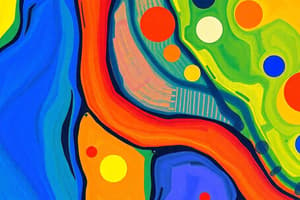Podcast
Questions and Answers
What is the main source of energy used in primary active transport?
What is the main source of energy used in primary active transport?
ATP
Describe the role of carrier proteins in secondary active transport.
Describe the role of carrier proteins in secondary active transport.
Carrier proteins couple the movement of a substance against its concentration gradient with the movement of another substance using the stored energy in the gradient.
How does secondary active transport differ from primary active transport in terms of energy usage?
How does secondary active transport differ from primary active transport in terms of energy usage?
Secondary active transport does not involve ATP hydrolysis directly, unlike primary active transport.
Give an example of a specialized pump involved in primary active transport.
Give an example of a specialized pump involved in primary active transport.
Explain the difference between a symporter and an antiporter in secondary active transport.
Explain the difference between a symporter and an antiporter in secondary active transport.
How do deficiencies in active transport systems impact physiological processes?
How do deficiencies in active transport systems impact physiological processes?
Explain the process of osmosis in biological systems.
Explain the process of osmosis in biological systems.
What is the main difference between simple diffusion and facilitated diffusion?
What is the main difference between simple diffusion and facilitated diffusion?
How does primary active transport differ from secondary active transport?
How does primary active transport differ from secondary active transport?
What role do membrane proteins play in facilitated diffusion?
What role do membrane proteins play in facilitated diffusion?
Explain why simple diffusion does not require cellular energy input.
Explain why simple diffusion does not require cellular energy input.
How does osmosis contribute to the regulation of water balance in cells?
How does osmosis contribute to the regulation of water balance in cells?
Flashcards are hidden until you start studying
Study Notes
Understanding Transport Mechanisms in Biological Systems
In living organisms, the transport of substances across cell membranes plays a crucial role in maintaining homeostasis and supporting life processes. This transport can occur through several mechanisms: passive transport, such as simple diffusion, osmosis, and facilitated diffusion, or active transport, including primary active transport and secondary active transport. Each method serves distinct purposes and relies on varying levels of cellular energy input.
Passive Transport
Simple Diffusion
Simple diffusion involves the movement of molecules or ions across a semipermeable membrane from an area of high concentration to an area of low concentration. This phenomenon happens spontaneously and does not require energy input from the cell.
Osmosis
Osmosis is a form of passive transport where water molecules move from a region of low solute concentration (high water concentration) to a region of high solute concentration (low water concentration).
Facilitated Diffusion
Facilitated diffusion utilizes membrane proteins called carriers or channels to facilitate the passage of molecules across the membrane. While still requiring no cellular energy input, facilitated diffusion allows for faster and selective passage of specific substances.
Active Transport
Primary Active Transport
Primary active transport uses the direct energy from ATP hydrolysis to move molecules or ions against their concentration gradient. This type of transport often involves specialized pumps, such as sodium-potassium pumps, which utilize ATP to maintain the cell's internal environment.
Secondary Active Transport
Secondary active transport does not involve ATP hydrolysis directly. Instead, it exploits the presence of an electrochemical gradient established through primary active transport processes. Here, a carrier protein couples the movement of a substance against its concentration gradient with the movement of another substance either in the same direction (symporter) or in the opposite direction (antiporter), utilizing the stored energy in the gradient.
These transport mechanisms serve essential functions within cells, allowing for communication between cells, maintenance of intracellular conditions, and the uptake of necessary nutrients. Deficiencies in active transport systems can lead to disorders affecting various physiological processes, as seen in diseases like cystic fibrosis and cholera.
Studying That Suits You
Use AI to generate personalized quizzes and flashcards to suit your learning preferences.




